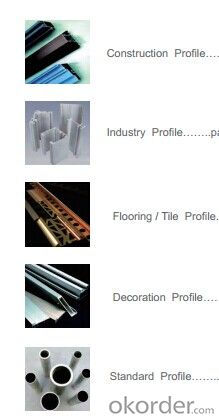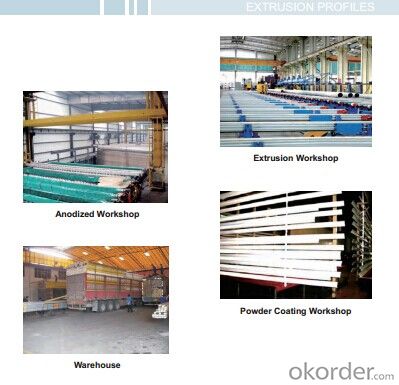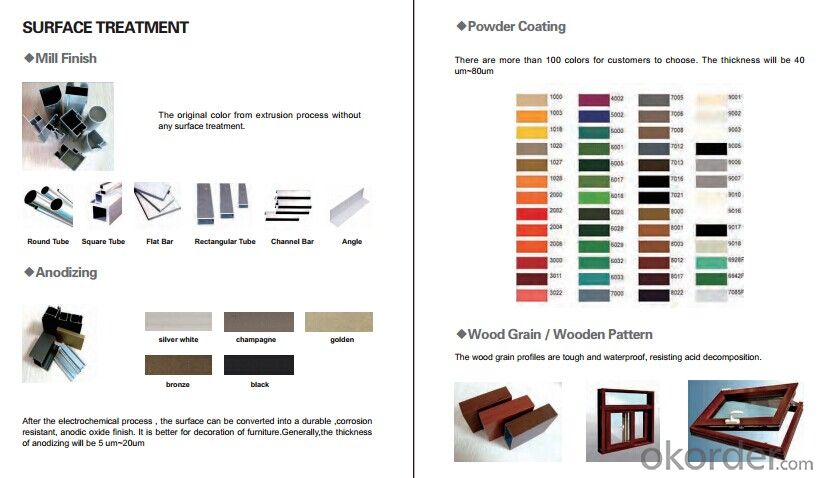Aluminium profile extrusion 6063
- Loading Port:
- China Main Port
- Payment Terms:
- TT OR LC
- Min Order Qty:
- -
- Supply Capability:
- -
OKorder Service Pledge
OKorder Financial Service
You Might Also Like
Aluminium is a relatively soft,durable, lightweight, ductile and malleablemetal with appearance ranging from silvery to dull gray,depending on the surface roughness. It is nonmagnetic and does not easilyignite. A fresh film of aluminium serves as a good reflector (approximately92%) of visible light and an excellent reflector (as much as98%) of medium and far infrared radiation. The yield strength of pure aluminium is 7–11 MPa,while aluminium alloys have yield strengths ranging from200 MPa to 600 MPa. Aluminium has about one-third the density and stiffnessof steel. It iseasily machined,cast, drawn and extruded.
Aluminum Profile
Material | Alloy 6063,6061,6005or according to customer’s choice |
Temper | T3, T4, T5, T6 |
Surface | Anodize, electrophoresis, powder coating, PVDF coating, wood grain painting, matted, etc. |
Length | Coating 6.5 meters, Anodizing 6.5 meters, Mill finish 5 meters |
Application | Industrial, electrical equipment(TV set, air conditioner, refrigerator, computer), decoration,construction, transportation |
Custom Made | We can package following with customer's request. |



- Q:RT: you! What are coated aluminum profiles? What's the surface treatment? What's the difference between grain transfer and wood grain transfer? Thank you first!!!
- First, the noun explanation:Aluminum is coated on the surface of various lines in aluminum on the coated PVC film, decorative paint paper, wood skin, and instead of the traditional painting process, the formation of decorative materials, coating materials can be used for the production of door, wardrobe Rome top line, Rome line, column, wardrobe baseboard, gusset plate, curtain rod Aluminum Alloy, window, doors and windows, frames etc..Two. The origin of coated aluminum profile:Aluminum Alloy profiles the most common and most primitive (referred to as aluminum), is Aluminum Alloy itself color, silver white, but this state for a long time, Aluminum Alloy surface will be oxidized into a dark gray or black. In order to solve this problem, the most common practice in our country is to spray a layer of powder (high temperature treatment) on the surface, that is electrostatic powder spraying. Also, fluorocarbon electrophoresis processing processing, wood grain transfer, the transfer grain processing fidelity is not high, in order to solve this problem, there are a kind of film processing, high fidelity, but because the process requirements must be done in the film before powder spraying treatment, coupled with higher requirement on the film itself, so the cost is higher, more for a second tier city high-grade residential.
- Q:Can aluminum profiles be used in modular exhibition system manufacturing?
- Yes, aluminum profiles can be used in modular exhibition system manufacturing. Aluminum profiles are known for their lightweight and durable properties, making them ideal for constructing modular exhibition systems. They are easy to handle and assemble, allowing for quick and efficient installation and dismantling of exhibition booths. Additionally, aluminum profiles can be easily customized and reconfigured to meet specific design requirements, making them a versatile choice for modular exhibition system manufacturing.
- Q:How do aluminum profiles perform in terms of UV resistance?
- Good UV resistance is typically offered by aluminum profiles. Protection against UV radiation is provided to some extent by the natural oxide layer that forms on the surface of aluminum. However, the UV resistance performance of aluminum profiles can vary depending on factors like the specific alloy used, the quality of surface treatment, and the environmental conditions to which they are exposed. Alloys with higher copper content, such as 6000 series aluminum, generally have better UV resistance compared to pure aluminum or alloys with lower copper content. This is because copper enhances the ability of the natural oxide layer to withstand UV radiation. Proper anodizing or powder coating processes tend to improve the UV resistance of aluminum profiles in terms of surface treatment. Anodizing involves the creation of a thicker and more durable oxide layer on the surface of the aluminum, enhancing its ability to resist UV damage. On the other hand, powder coating involves the application of a protective polymer layer to the aluminum surface, acting as a barrier against UV radiation. The UV resistance of aluminum profiles can also be influenced by environmental conditions. Intense sunlight, high temperatures, and exposure to pollutants or corrosive substances can accelerate the degradation of the oxide layer, thereby reducing overall UV resistance. Regular cleaning and maintenance can help extend the lifespan and UV resistance of aluminum profiles. To summarize, aluminum profiles generally offer good UV resistance due to the presence of a natural oxide layer on the surface. The performance in terms of UV resistance can be influenced by factors such as alloy composition, surface treatment, and environmental conditions. It is advisable to consult manufacturers or suppliers to ensure that the specific aluminum profiles meet the required UV resistance for the intended application.
- Q:What is the opening section of aluminum profile?
- The opening position and the closed position are corresponding to the open section bar and the closed section section. Closed form refers to the outer contour of a profile forming a closed box shaped body; the opening is an outer contour without closure or no full closure. However, many practical profiles are more complex, with closed parts and open parts, which naturally produce "opening parts" and "closed parts"".The minimum column section thickness of the main stress parts, mainly referring to the national standard "Aluminum Alloy" building material GB/T5237 on the wall with a minimum thickness profile for 3.0mm, for the closed box section, with good resistance to local instability of the performance, can use a smaller wall thickness, the minimum wall thickness 2.5mm profiles, thus allowing.
- Q:What are the color options available for aluminum profiles?
- The color options available for aluminum profiles are vast and can be customized to suit individual preferences and design needs. Some common color options include natural aluminum (silver), white, black, bronze, and various shades of grey. Additionally, it is possible to select custom colors by applying powder coating or anodizing processes to the aluminum profiles. These processes allow for a wide range of colors to be achieved, including vibrant hues and metallic finishes. Ultimately, the color options for aluminum profiles are extensive, enabling individuals to find the perfect match for their specific project or aesthetic requirements.
- Q:Can aluminum profiles be used in marine environments?
- Yes, aluminum profiles can be used in marine environments. Aluminum is often chosen for its excellent corrosion resistance and lightweight properties, making it ideal for marine applications. It is commonly used in the construction of boats, shipbuilding, and offshore structures due to its durability and ability to withstand exposure to saltwater and harsh weather conditions.
- Q:Can aluminum profiles be used in signage or display applications?
- Yes, aluminum profiles can be used in signage or display applications. Aluminum profiles are versatile and lightweight, making them ideal for creating durable and visually appealing signs and displays. They can be easily cut, shaped, and joined together to create custom frames, panels, and structures for various signage and display purposes. Aluminum profiles also offer excellent corrosion resistance, ensuring that the signs or displays remain intact and attractive even in outdoor or high-moisture environments. Additionally, aluminum profiles can be powder coated or anodized to provide a wide range of color options, allowing for branding or customization. Overall, aluminum profiles offer a reliable and cost-effective solution for signage or display applications, providing both functionality and aesthetics.
- Q:Can aluminum profiles be custom-designed or customized?
- Aluminum profiles have the ability to be tailored or personalized to meet specific demands. Aluminum is a remarkably adaptable material that can be easily molded and shaped into a variety of forms. By customizing aluminum profiles, it becomes possible to create distinct shapes, sizes, and finishes that fulfill the precise requirements of various applications. The customization and custom design of aluminum profiles encompass a range of possibilities. This can involve modifying dimensions, crafting intricate shapes, adding slots or holes for assembly, incorporating specific features or accessories, and even applying diverse surface treatments or coatings. Such design flexibility permits the utilization of aluminum profiles in numerous industries and applications, including construction, automotive, aerospace, electronics, and many more. The process of customizing aluminum profiles typically involves a collaborative effort between the manufacturer and the customer. The manufacturer works closely with the customer to comprehend their requirements, provide technical support, and propose design solutions that align with their specific needs. This collaboration may entail creating prototypes, conducting tests, and making adjustments until the desired custom design is achieved. In conclusion, aluminum profiles can indeed be custom-designed or customized to cater to specific requirements, rendering them a favored choice for numerous industries seeking distinctive and tailored solutions.
- Q:Can aluminum profiles be used in the construction of exhibition booths?
- Yes, aluminum profiles can be used in the construction of exhibition booths. Aluminum profiles are lightweight, durable, and easy to assemble, making them a popular choice for constructing exhibition booths. They can be customized to fit specific design requirements and can be easily transported and reused for multiple exhibitions.
- Q:Can aluminum profiles be used in swimming pool enclosures or structures?
- Yes, aluminum profiles can be used in swimming pool enclosures or structures. Aluminum is a lightweight and corrosion-resistant material that is commonly used in construction projects, including swimming pool enclosures. Its durability and strength make it an ideal choice for withstanding the harsh pool environment, providing a long-lasting and aesthetically pleasing solution.
1. Manufacturer Overview |
|
|---|---|
| Location | |
| Year Established | |
| Annual Output Value | |
| Main Markets | |
| Company Certifications | |
2. Manufacturer Certificates |
|
|---|---|
| a) Certification Name | |
| Range | |
| Reference | |
| Validity Period | |
3. Manufacturer Capability |
|
|---|---|
| a)Trade Capacity | |
| Nearest Port | |
| Export Percentage | |
| No.of Employees in Trade Department | |
| Language Spoken: | |
| b)Factory Information | |
| Factory Size: | |
| No. of Production Lines | |
| Contract Manufacturing | |
| Product Price Range | |
Send your message to us
Aluminium profile extrusion 6063
- Loading Port:
- China Main Port
- Payment Terms:
- TT OR LC
- Min Order Qty:
- -
- Supply Capability:
- -
OKorder Service Pledge
OKorder Financial Service
Similar products
New products
Hot products
Hot Searches
Related keywords






























